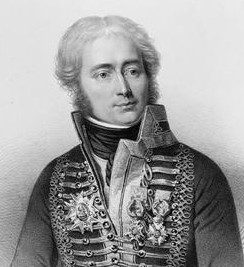General Louis-François Foucher de Careil

Born: December 18, 1762
Place of Birth: Guérande, Loire-Atlantique, France
Died: August 22, 1835
Place of Death: Garches, France
Arc de Triomphe: FOUCHER on the east pillar
Pronunciation:
Foucher de Careil began his military career by enrolling at the artillery school of Metz in September of 1781, and three years later he was commissioned as a lieutenant in the regiment of artillery at Toul. With the advent of the Revolution, he was promoted to captain in 1791 and stationed at Strasbourg before taking command of the 3rd Company of Horse Artillery and joining the Army of the Rhine. He saw action during the retreat from Frankfurt and the defense of Mainz before being promoted to chef de bataillon and then serving in the Vendée.
In 1794 Foucher de Careil took command of the horse artillery of the advance guard of the Army of the Western Pyrenees, and was then promoted to chef de brigade and given the 6th Regiment of Horse Artillery. Transferred to the Army of the Sambre and Meuse, he successively took command of the the artillery of the center, then the right wing, and finally the horse artillery of the entire army.
By 1799 Foucher de Careil was given command of the artillery of the advance guard of the left wing of the Army of the Danube and Switzerland. That year he fought at Liptngen, Zurich, and Winterthur. The next year he served with the Army of the Rhine, and distinguished himself at Hohenlinden. During the peaceful years that followed, he served in garrison at Rennes and Auxonne, and received a promotion to général de brigade.
After a stint commanding the artillery school at Metz, General Foucher de Careil was named deputy commander of the artillery at the camp of Saint-Omer. When war broke out, he was given command of all the artillery of V Corps under Marshal Lannes, a position he held throughout the campaigns of 1805-1807. He took part in the fighting at Ulm, and was wounded by a piece of shell to the thigh at Gunthersdorff in November of 1805. That December he fought at Austerlitz.
In 1806, Foucher de Careil was briefly named Inspector of Artillery, but he continued his combat duties by fighting at Jena and Pultusk . In March of 1807 he received a promotion to général de division, and then in 1808 was named a Baron of the Empire.
In early 1809, Foucher de Careil followed his former commander Marshal Lannes to Spain and took over the artillery of the Siege of Saragossa. That March he returned to Paris to then become deputy commander of the artillery of the Army of Germany. The next year he returned to Spain, this time under Junot, to lead the artillery of VIII Corps. In 1811 he took over the artillery of the Army of the North in Spain, and then later was named Directory of Artillery in Spain. He would go on to command the artillery of the Corps of Observation of Bayonne and then later returned to France.
For the campaign against Russia in 1812, Foucher de Careil became commander of artillery of his corps which was now renamed to III Corps commanded by Marshal Ney. In this capacity he fought at Borodino and survived the retreat. In 1813 he took command of the artillery of Marshal Marmont's VI Corps and served in Saxony. Late that year he was rewarded as a Grand Officer of the Legion of Honor.
In February of 1814, Foucher de Careil was employed in Macdonald's XI Corps. After Napoleon's abdication, the king sent Foucher de Careil to direct handing over the city of Hamburg to the allies. Once his mission was complete, he returned to France and was well treated by the Bourbons.
Bibliography
Updated June 2016
© Nathan D. Jensen